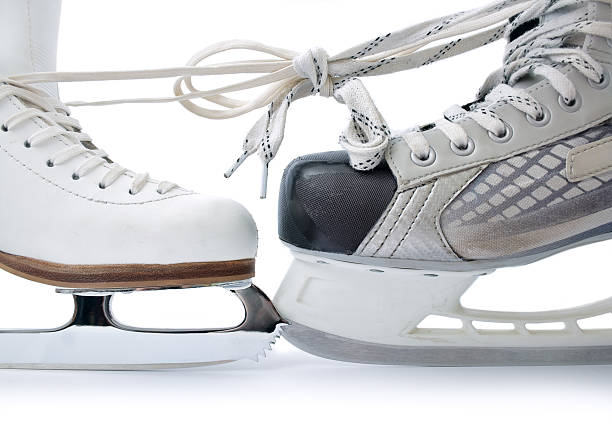Synchronized Skating: The Unsung Symphony on Ice
Synchronized skating, a captivating blend of artistry and precision, remains one of the most underappreciated disciplines in the world of ice sports. This team-based figure skating event combines the grace of ballet with the synchronicity of synchronized swimming, creating a mesmerizing spectacle on ice. Despite its growing popularity and the push for Olympic recognition, synchronized skating often flies under the radar of mainstream sports coverage. This article delves into the intricate world of synchronized skating, exploring its history, techniques, and the dedication required to excel in this demanding sport.

The Birth of a Frozen Ballet
Synchronized skating traces its roots back to 1956 when Dr. Richard Porter formed the first synchronized skating team, then called precision skating, at the University of Michigan. Porter’s vision was to create a team-based figure skating discipline that would allow more skaters to participate competitively. The sport slowly gained traction, with the first official competition held in Ann Arbor, Michigan, in 1976.
Initially, the focus was on geometric formations and precise lines, much like a military drill on ice. Teams would create shapes such as circles, wheels, and lines, emphasizing uniformity and exactness. As the sport evolved, it began incorporating more complex elements from singles and pairs skating, including lifts, spins, and footwork sequences.
The International Skating Union (ISU) officially recognized synchronized skating as a discipline in 1994, paving the way for international competitions and standardized judging criteria. The first World Synchronized Skating Championships were held in 2000 in Minneapolis, Minnesota, marking a significant milestone in the sport’s history.
The Anatomy of a Synchronized Skating Team
A typical synchronized skating team consists of 16 skaters, although some divisions allow for teams of 12 to 20 members. The large team size is one of the unique aspects of synchronized skating, requiring a level of coordination and teamwork unparalleled in other ice sports.
Teams are divided into various levels based on age and skill, from juvenile to senior. At the highest level, skaters must possess a combination of strong individual skating skills and the ability to move in perfect unison with their teammates. This demands not only physical prowess but also acute spatial awareness and timing.
The roles within a team are diverse and crucial. While there are no designated positions like in hockey or soccer, certain skaters may take on leadership roles during specific elements. For instance, in a wheel formation, one skater acts as the pivot, setting the pace and direction for the entire team.
Mastering the Elements: Techniques and Challenges
Synchronized skating programs are a complex tapestry of elements, each requiring precise execution and teamwork. Some of the key elements include:
- Blocks: Skaters form tight formations, often in rectangular shapes, and move across the ice in unison.
- Circles: Teams create one or more circular formations, rotating in intricate patterns.
- Wheels: Skaters form spokes radiating from a central point, resembling a wheel in motion.
- Intersections: Perhaps one of the most thrilling elements, where lines of skaters pass through each other at high speeds.
- Lifts and pair elements: In senior-level competitions, teams can incorporate lifts and pair skating moves, adding an extra layer of difficulty and excitement.
- Step sequences: Synchronized footwork performed by the entire team, showcasing edge work and skating skills.
The challenge lies not just in executing these elements individually, but in performing them with 15 other skaters in perfect synchronization. Timing is critical; a fraction of a second can mean the difference between a flawless maneuver and a jarring misstep.
The Physical and Mental Demands of Synchronized Skating
Synchronized skating is a sport that demands peak physical conditioning. Skaters must possess a combination of strength, flexibility, and endurance. The cardiovascular demands are particularly high, as programs can last up to four and a half minutes, requiring sustained energy and focus throughout.
Strength training is crucial, particularly for the lower body and core. Skaters need powerful legs for jumps and quick direction changes, and a strong core for maintaining posture and balance during complex maneuvers. Flexibility is equally important, allowing skaters to achieve the graceful lines and positions that give synchronized skating its aesthetic appeal.
Mental preparation is perhaps even more critical than physical training. The need for absolute precision and teamwork creates a unique psychological pressure. Skaters must develop intense focus and the ability to perform under stress. They must also cultivate a strong sense of spatial awareness, constantly maintaining their position relative to their teammates while executing complex movements.
Team dynamics play a crucial role in success. Unlike individual figure skating, where a skater’s performance depends solely on their own abilities, synchronized skating requires seamless cooperation among all team members. This necessitates hours of practice to develop not just individual skills, but also a collective rhythm and understanding.
The Judging System: Balancing Technicality and Artistry
The judging of synchronized skating has evolved significantly since its early days. Today, it uses a system similar to that used in other figure skating disciplines, with separate technical and program component scores.
The technical score evaluates the execution of specific elements. Judges look for precision in formations, speed, and unison. They also assess the difficulty of the elements performed. For instance, an intersection where skaters pass through each other while performing twizzles (a type of traveling spin) would receive a higher base value than a simpler straight-line intersection.
The program component score considers five aspects:
- Skating Skills: The quality of edge control, flow over the ice, and clarity of technique.
- Transitions: The varied and purposeful use of intricate footwork, positions, movements, and holds that link all elements.
- Performance: The involvement of the team physically, emotionally, and intellectually as they deliver the intent of the music and composition.
- Composition: The purposeful arrangement of all types of movements according to the principles of proportion, unity, space, pattern, and musical structure.
- Interpretation: The personal, creative, and genuine translation of the rhythm, character, and content of the music to movement on ice.
This dual focus on technical proficiency and artistic expression creates a challenging balancing act for teams. They must push the boundaries of difficulty while maintaining the grace and fluidity that make synchronized skating a captivating spectacle.
The Global Stage: Competitions and Championships
While synchronized skating has yet to be included in the Winter Olympics, it has a robust competitive structure at both national and international levels. The pinnacle of the sport is the ISU World Synchronized Skating Championships, held annually since 2000.
Nations such as Finland, Sweden, Canada, and the United States have historically dominated the sport, but recent years have seen rising competition from countries like Russia and Japan. This global spread has led to increased diversity in skating styles and program themes, enriching the sport’s artistic landscape.
Major competitions often attract thousands of spectators, creating an electric atmosphere that rivals any Olympic event. The passion of the fans, combined with the visual spectacle of perfectly synchronized teams, creates an unforgettable experience for both participants and audience members.
The Push for Olympic Recognition
Despite its growing popularity and the high level of skill required, synchronized skating is not yet an Olympic sport. The push for Olympic inclusion has been ongoing for years, with proponents arguing that it would bring much-needed attention and resources to the discipline.
The main obstacles to Olympic inclusion have been logistical. With teams of 16 skaters, plus alternates and coaches, synchronized skating would require a significant increase in the athlete quota for the Winter Games. There are also concerns about the additional ice time needed for practices and competitions.
However, supporters argue that the unique nature of synchronized skating – its emphasis on teamwork, its visual appeal, and its potential to attract new audiences – make it an ideal addition to the Olympic program. They point to the success of team events in other winter sports, such as the team figure skating event introduced in 2014, as evidence of the appeal of collaborative ice sports.
The Future of Synchronized Skating: Innovations and Challenges
As synchronized skating continues to evolve, several trends are shaping its future:
- Technological Integration: Teams are increasingly using technology in their training, from video analysis software to wearable devices that track skaters’ movements and synchronization.
- Artistic Innovation: Programs are becoming more thematically complex, with teams pushing the boundaries of storytelling on ice. This includes more diverse music choices and innovative costume designs.
- Athletic Progression: The physical demands of the sport continue to increase, with teams incorporating more difficult elements from other skating disciplines.
- Grassroots Development: Many countries are focusing on building strong developmental programs to ensure a pipeline of talent for the future.
However, challenges remain. The cost of participating in synchronized skating can be prohibitive, with expenses for ice time, travel, and costumes adding up quickly. This can limit accessibility and diversity within the sport.
There’s also an ongoing debate about the balance between athleticism and artistry. As teams push for more difficult technical elements, some worry about losing the graceful, flowing quality that makes synchronized skating unique.
The Impact of Synchronized Skating on Individual Development
Beyond its merits as a competitive sport, synchronized skating offers numerous benefits to its participants. The team-based nature of the discipline fosters strong social bonds and teaches valuable lessons in cooperation and communication.
Skaters develop a keen sense of body awareness and spatial relations, skills that translate well to other areas of life. The discipline required to maintain the rigorous practice schedule often leads to improved time management skills and academic performance.
Moreover, synchronized skating provides a competitive outlet for skaters who may not excel in individual figure skating disciplines. It allows a broader range of athletes to experience the thrill of high-level competition and the satisfaction of being part of a team.
Synchronized Skating’s Cultural Impact
While still a niche sport in many parts of the world, synchronized skating has developed a passionate and dedicated following. In countries where it’s more established, like Finland and Sweden, it has become an integral part of the winter sports culture.
The sport has also had a notable impact on figure skating as a whole. Many of the transitional moves and creative formations developed in synchronized skating have found their way into singles and pairs programs, enriching these disciplines with new artistic possibilities.
Synchronized skating events often become community celebrations, particularly in smaller towns and cities. The local team becomes a source of pride, bringing together people of all ages to support their skaters.
The Unsung Heroes: Coaches and Choreographers
Behind every successful synchronized skating team stands a dedicated coaching staff. These unsung heroes face the unique challenge of molding up to 20 individual skaters into a cohesive unit.
Coaches in synchronized skating must possess a diverse skill set. They need to understand the technical aspects of figure skating, have a keen eye for detail to ensure perfect synchronization, and possess strong leadership skills to manage team dynamics.
Choreographers in synchronized skating face the exciting challenge of creating programs that showcase both individual and collective talents. They must consider the strengths and weaknesses of each skater while designing formations and transitions that will wow judges and audiences alike.
The role of these professionals extends beyond the ice. They often serve as mentors, helping young skaters navigate the challenges of competitive sports and personal growth.
The Role of Music in Synchronized Skating
Music plays a crucial role in synchronized skating, serving as more than just a backdrop to the performance. The choice of music can make or break a program, influencing both the technical execution and the emotional impact on judges and audiences.
Teams typically skate to a wide range of music, from classical compositions to modern pop songs. The key is selecting music that allows for a variety of tempos and moods, giving the team opportunities to showcase different skills and emotions throughout their program.
Interpreting the music is a critical skill in synchronized skating. Teams must not only move in unison but also express the character and emotion of the music collectively. This requires a deep understanding of the musical structure and themes, translated into movement on ice.
Some teams have pushed the boundaries of musical interpretation in synchronized skating. For example, programs have been created around complex narratives, with the music and choreography telling a cohesive story from start to finish.
The Technical Evolution of Synchronized Skating
Over the years, synchronized skating has seen a significant evolution in its technical elements. What started as simple formations and step sequences has grown into a complex array of intricate maneuvers.
One of the most dramatic developments has been the introduction of pair elements in senior-level competitions. Teams now incorporate moves traditionally seen in pairs skating, such as lifts and death spirals, adding an extra layer of difficulty and excitement to their programs.
The complexity of intersections has also increased dramatically. Early intersections were simple pass-throughs, but modern teams execute multi-rotational turns or jumps as they intersect, requiring split-second timing and precision.
Step sequences have become more intricate, with teams performing complex footwork in perfect unison. These sequences often incorporate elements from ice dance, further blurring the lines between skating disciplines.
The introduction of the IJS (International Judging System) in synchronized skating has also driven technical innovation. Teams now strategically construct their programs to maximize point potential, leading to more diverse and challenging routines.
Training Regimens: On and Off the Ice
The training required for synchronized skating is intense and multifaceted. On-ice practice is, of course, essential, with teams typically spending several hours a day perfecting their routines and individual skating skills.
Off-ice training is equally important. Strength and conditioning work is crucial to build the stamina needed for long programs and the strength required for lifts and other difficult elements. Many teams incorporate dance classes into their training regimens to improve grace, flexibility, and body awareness.
Mental training is also a key component. Teams often work with sports psychologists to develop focus, manage performance anxiety, and build team cohesion. Visualization techniques are commonly used to help skaters memorize complex routines and improve synchronization.
Cross-training in other sports can also be beneficial. Many synchronized skaters participate in activities like yoga, Pilates, or swimming to improve overall fitness and prevent injuries.
The Economic Landscape of Synchronized Skating
While not as lucrative as some other winter sports, synchronized skating has its own economic ecosystem. At the highest levels, some countries provide funding for national teams, covering expenses for training, travel, and competition.
However, for many teams, especially at junior levels, funding can be a significant challenge. Costs for ice time, coaching, costumes, and travel can be substantial. Many teams rely on fundraising efforts, sponsorships, and parental support to meet these expenses.
The economic impact of synchronized skating extends beyond the teams themselves. Major competitions can bring significant tourism revenue to host cities, with thousands of athletes, coaches, and spectators attending events.
There’s also a growing industry around synchronized skating equipment and apparel. Specialized team uniforms, practice wear, and accessories form a niche market within the broader figure skating industry.
Synchronized Skating and Gender Dynamics
Historically, synchronized skating has been a female-dominated sport, but this is slowly changing. More male skaters are becoming involved, particularly in countries where the sport is well-established.
The inclusion of male skaters has brought new dynamics to team compositions and choreography. Mixed-gender teams can create interesting visual contrasts and allow for more diverse lift elements.
However, the sport still faces challenges in achieving gender balance. Efforts are being made at grassroots levels to encourage more male participation, with some countries offering special programs and incentives for male synchronized skaters.
The evolving gender dynamics in synchronized skating reflect broader conversations about gender in sports, challenging traditional notions of “male” and “female” sports.
The Global Spread: Synchronized Skating Around the World
While synchronized skating originated in North America, it has spread to become a truly global sport. Different regions have developed their own styles and strengths, contributing to the rich tapestry of the discipline.
In North America, teams often emphasize speed and technical difficulty. European teams, particularly from Nordic countries, are known for their precise formations and elegant skating skills. Asian teams have made significant strides in recent years, often bringing unique artistic interpretations to their programs.
The global nature of the sport has led to interesting cultural exchanges. Teams often incorporate elements of their national culture into their programs, from music choices to costume designs, adding a layer of cultural education to competitions.
As the sport continues to grow globally, there are efforts to develop it in non-traditional skating countries. Clinics and development programs are being conducted in countries where winter sports are less common, aiming to broaden the sport’s reach and diversity.
The Psychological Aspects of Synchronized Skating
The mental demands of synchronized skating are unique and intense. Skaters must not only manage their own performance anxiety but also maintain awareness of their teammates at all times.
Trust is a crucial psychological component. Skaters must have complete faith in their teammates, particularly during high-risk elements like intersections or lifts. Building this trust requires time and can be challenging, especially when new members join the team.
The pressure of performing as a unit can be both a blessing and a curse. On one hand, skaters can draw strength and confidence from their teammates. On the other, the fear of letting the team down can create additional stress.
Teams often develop rituals and routines to manage pre-competition nerves and build team spirit. These can range from group warm-up exercises to motivational chants or quiet moments of collective focus.
Injury Prevention and Management in Synchronized Skating
Like all ice sports, synchronized skating carries a risk of injury. Common injuries include ankle sprains, knee injuries, and lower back pain. The unique demands of the sport also present specific risks, such as collisions during intricate formations or falls during lift elements.
Injury prevention is a key focus for teams and coaches. This includes proper warm-up and cool-down routines, strength training to support joints and prevent imbalances, and careful progression in difficulty to ensure skaters are prepared for more challenging elements.
Teams also put significant emphasis on recovery techniques. This can include regular physiotherapy, massage, and the use of tools like foam rollers and compression





